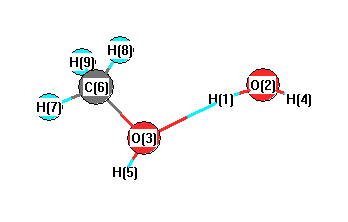Vibrational Frequencies calculated at CCSD(T)/3-21G
| Mode Number |
Symmetry |
Frequency
(cm-1) |
Scaled Frequency
(cm-1) |
IR Intensities
(km mol-1) |
Raman Act
(Å4/u) |
Dep P |
Dep U |
|---|
| 1 |
A |
3538 |
3505 |
|
|
|
|
| 2 |
A |
3450 |
3417 |
|
|
|
|
| 3 |
A |
3386 |
3354 |
|
|
|
|
| 4 |
A |
3119 |
3089 |
|
|
|
|
| 5 |
A |
3096 |
3067 |
|
|
|
|
| 6 |
A |
3019 |
2990 |
|
|
|
|
| 7 |
A |
1781 |
1764 |
|
|
|
|
| 8 |
A |
1605 |
1590 |
|
|
|
|
| 9 |
A |
1563 |
1549 |
|
|
|
|
| 10 |
A |
1492 |
1478 |
|
|
|
|
| 11 |
A |
1393 |
1380 |
|
|
|
|
| 12 |
A |
1164 |
1153 |
|
|
|
|
| 13 |
A |
1073 |
1063 |
|
|
|
|
| 14 |
A |
942 |
933 |
|
|
|
|
| 15 |
A |
813 |
805 |
|
|
|
|
| 16 |
A |
572 |
567 |
|
|
|
|
| 17 |
A |
310 |
307 |
|
|
|
|
| 18 |
A |
252 |
250 |
|
|
|
|
| 19 |
A |
239 |
237 |
|
|
|
|
| 20 |
A |
204 |
202 |
|
|
|
|
| 21 |
A |
156 |
154 |
|
|
|
|
Unscaled Zero Point Vibrational Energy (zpe) 16582.7 cm
-1
Scaled (by 0.9906) Zero Point Vibrational Energy (zpe) 16426.9 cm
-1
See section
III.C.1 List or set vibrational scaling factors
to change the scale factors used here.
See section
III.C.2
Calculate a vibrational scaling factor for a given set of molecules
to determine the least squares best scaling factor.
Charges, Dipole, Quadrupole and Polarizability
Charges from optimized geometry at CCSD(T)/3-21G
Charges (e)
| Number |
Element |
Mulliken |
CHELPG |
AIM |
ESP |
| 1 |
H |
0.396 |
|
|
|
| 2 |
O |
-0.775 |
|
|
|
| 3 |
O |
-0.656 |
|
|
|
| 4 |
H |
0.345 |
|
|
|
| 5 |
H |
0.382 |
|
|
|
| 6 |
C |
-0.338 |
|
|
|
| 7 |
H |
0.192 |
|
|
|
| 8 |
H |
0.221 |
|
|
|
| 9 |
H |
0.233 |
|
|
|
Electric dipole moments
Electric dipole components in Debye
(What's a Debye? See section
VII.A.3)
| |
x |
y |
z |
Total |
| |
1.945 |
-0.754 |
0.219 |
2.097 |
| CHELPG |
|
|
|
|
| AIM |
|
|
|
|
| ESP |
|
|
|
|
Electric Quadrupole moment
Quadrupole components in D Å
Polarizabilities
Components of the polarizability tensor.
Units are
Å
3 (Angstrom cubed)
Change units.
| |
x |
y |
z |
| x |
0.000 |
0.000 |
0.000 |
| y |
0.000 |
0.000 |
0.000 |
| z |
0.000 |
0.000 |
0.000 |
<r2> (average value of r
2) Å
2
| <r2> |
0.000 |
| (<r2>)1/2 |
0.000 |
